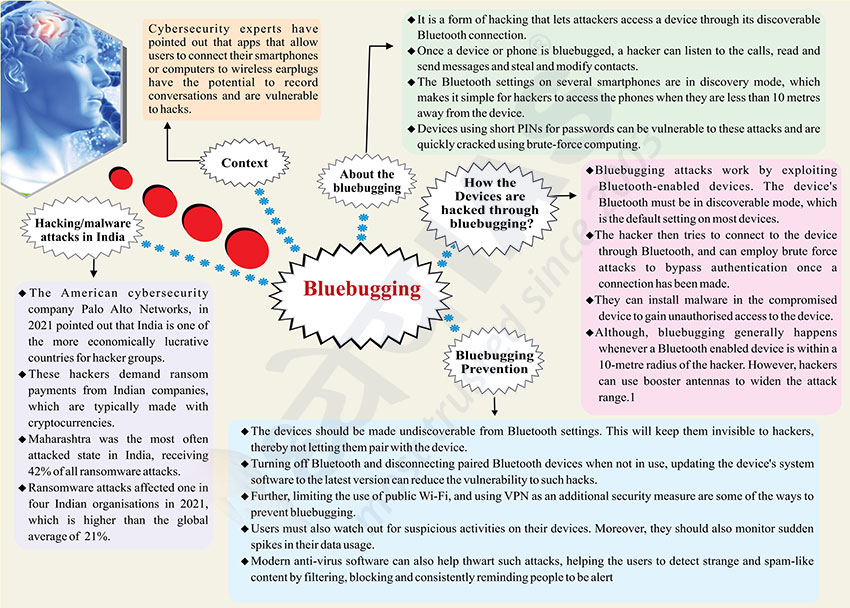Brain-booster
/
27 Dec 2022
Brain Booster for UPSC & State PCS Examination (Topic: Bluebugging)

Context
- Cybersecurity experts have pointed out that apps that allow users to
connect their smartphones or computers to wireless earplugs have the
potential to record conversations and are vulnerable to hacks.
About the bluebugging
- It is a form of hacking that lets attackers access a device through its
discoverable Bluetooth connection.
- Once a device or phone is bluebugged, a hacker can listen to the calls,
read and send messages and steal and modify contacts.
- The Bluetooth settings on several smartphones are in discovery mode,
which makes it simple for hackers to access the phones when they are less
than 10 metres away from the device.
- Devices using short PINs for passwords can be vulnerable to these
attacks and are quickly cracked using brute-force computing.
How the Devices are hacked through bluebugging?
- Bluebugging attacks work by exploiting Bluetooth-enabled devices. The
device's Bluetooth must be in discoverable mode, which is the default
setting on most devices.
- The hacker then tries to connect to the device through Bluetooth, and
can employ brute force attacks to bypass authentication once a connection
has been made.
- They can install malware in the compromised device to gain unauthorised
access to the device.
- Although, bluebugging generally happens whenever a Bluetooth enabled
device is within a 10-metre radius of the hacker. However, hackers can use
booster antennas to widen the attack range.1
Bluebugging Prevention
- The devices should be made undiscoverable from Bluetooth settings. This
will keep them invisible to hackers, thereby not letting them pair with the
device.
- Turning off Bluetooth and disconnecting paired Bluetooth devices when
not in use, updating the device's system software to the latest version can
reduce the vulnerability to such hacks.
- Further, limiting the use of public Wi-Fi, and using VPN as an
additional security measure are some of the ways to prevent bluebugging.
- Users must also watch out for suspicious activities on their devices.
Moreover, they should also monitor sudden spikes in their data usage.
- Modern anti-virus software can also help thwart such attacks, helping
the users to detect strange and spam-like content by filtering, blocking and
consistently reminding people to be alert
Hacking/malware attacks in India
- The American cybersecurity company Palo Alto Networks, in 2021 pointed
out that India is one of the more economically lucrative countries for
hacker groups.
- These hackers demand ransom payments from Indian companies, which are
typically made with cryptocurrencies.
- Maharashtra was the most often attacked state in India, receiving 42% of
all ransomware attacks.
- Ransomware attacks affected one in four Indian organisations in 2021,
which is higher than the global average of 21%.







